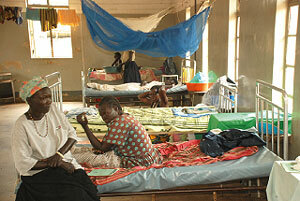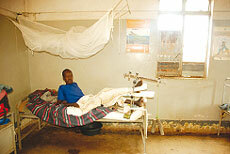Kitgum Hospital: A facility falling apart
Michael Abola, 14, is a miserable boy. Seated on his hospital bed, he is in pain and a stench emanates from severe wounds on his legs, which are undressed and have become an eyesore to the other patients sharing the ward with him.
By Frederick Womakuyu
Michael Abola, 14, is a miserable boy. Seated on his hospital bed, he is in pain and a stench emanates from severe wounds on his legs.
The wounds, which stretch from the toes to the knees, are undressed and have become an eyesore to the other patients sharing the ward with him.
This is in Kitgum Hospital, Kitgum district in northern Uganda, lying on the South Sudan border.
Abola is epileptic, and during one of the attacks, he fell in the fire and got burnt. He badly needed surgery and he was taken to hospital. However, at that time, the hospital had only one doctor and there was no specialist for surgery. Some time back, they recruited two more doctors, but there was still no specialist for surgery.
“He had to wait because there were some specialists coming from Lacor Hospital in Gulu, for a one-day clinic,” says Suzan Awuete, a nursing assistant at the hospital, who is also the head of the surgical ward that would, under normal circumstances, be headed by a doctor.
Later, the Lacor Hospital specialists worked on Abola, but not much has changed. He is writhing in pain and looks resigned to fate.
Supplies and staffing
Kitgum Hospital lacks essential equipment and supplies, and the infrastructure is inadequate.
Peter Bezy Omoya, the senior administrator, says the hospital, which serves over 300,000 people who come from as far as South Sudan and Karamoja, faces staffing shortages. The hospital has only three doctors, out of the 12 recommended by the health ministry and does not have specialists.

In the surgical ward, they are supposed to have a general surgeon and a specialist surgeon to work on patients. However, they do not have any of these, so patients suffer.
Until recently, the hospital did not have a doctor for its huge maternity wing that delivers over 20 babies per day. According to Christine Atube, a midwife, they could not carryout C-sections and many women had to be referred to the nearest St. Joseph Hospital or Gulu Hospital.
“However, by the time they are attended to, it is either delayed labour or they die,” explains Atube.
She adds that whereas there are supposed to be over 40 midwives, the hospital has only 15, many of whom have to attend to other departments.
The maternity wing is supposed to have over six midwives, but they have only two. Atube observes that due to this shortage, most staff work for longer hours, yet they earn very little.
She says midwives are also rarely promoted, and this has affected their morale. She also notes that there are no allowances for breakfast, lunch or accommodation, so they have to meet all these costs.
Kitgum Hospital also lacks equipment like a dental chair. Omoya says the one they had broke down and has not been repaired for years due to lack of spares.
That aside, the hospital lacks a dental surgeon.
Omanya adds that it is hard to work on patients with dental problems, although lower level cadres have been trained to help. He says the hospital is full of junior staff, with nursing officers making up the bigger percentage of workers. However, he says the junior officers cannot help much because they have limited skills.
For example, they cannot work on people with bone problems, carryout C-sections or operations.
Infrastructure
The hospital is full of dilapidated structures, including the intensive care unit and the mortuary that stands right in the heart of the hospital. The walls are peeling off and some parts are leaking.
The staff houses are also not enough, yet they are not in good state. Their walls are peeling off and the furniture is broken. The toilets are also dilapidated and dirty, and most of them have filled up.
Power crisis
Omoya explains that the hospital gets less than sh257m per month and this is supposed to carry out repairs, pay allowances for staff field visits, service vehicles and run the generator.
“It is also supposed to pay the huge electricity bill. So, by the end of the day, we have no money to carry out repairs. This is a tall order, so we can only do what we can,” adds Omoya.
He says the hospital requires over sh2b annually to run efficiently, but this is just a dream.
Kitgum Hospital, like any other government facility, gets power from the national grid. However, because of the incessant loadshedding, they have to rely on the generator, yet they cannot afford fuel most of the time. When this happens, it means they cannot light the hospital, so they resort to candles.

They cannot also run their fridges, so the medicine goes bad.
The two ambulances given to the hospital have also been grounded because they cannot afford to buy fuel. In fact, some patients complain that they are sometimes asked to buy fuel.
Omoya explains that while many ordinary people think they have everything to help them, in reality they are operating on a very small budget, with inadequate staffing.
“Our work is to help our people, but we can only do this within our means. I know they expect a lot from us, but the conditions are very difficult here,” he says.
Omoya observes that most hospital beds are broken and need repair. They also lack mattresses and blankets.
He says most of the beds are 30 years old and others are as old as the hospital itself, which was built in 1948.
According to the Uganda Bureau of Statistics, most of the people in Kitgum are poor, with over 70% of them living on a dollar a day.
So, they rely on the hospital for everything, including medication and beddings.
Machines
One thing the hospital is proud of is their X-ray and ultra sound scan machines that still function. Although they have failed to get a specialist to operate the machines, they have trained a low-level cadre to help.
The facility is also proud of its beautiful compound that is well-trimmed.Unlike other hospitals that complain of lack of drugs and supplies, the hospital is well-stocked with drugs, including ARVs.
According to Omoya, the hospital also has enough sanitary supplies such as gloves and bandages.
On the day I visited the facility, it was a Sunday, but most of the staff were attending to patients, something that is rare in many other facilities I have visited.